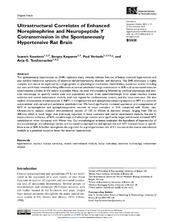| dc.contributor.author | Kourtesis, Ioannis | |
| dc.contributor.author | Kasparov, Sergey | |
| dc.contributor.author | Verkade, Paul | |
| dc.contributor.author | Teschemacher, Anja G. | |
| dc.date.accessioned | 2016-04-14T13:01:58Z | |
| dc.date.available | 2016-04-14T13:01:58Z | |
| dc.date.issued | 2015-10-29 | |
| dc.Published | ASN Neuro 2015, 7(5: 1759091415610115 ) | eng |
| dc.identifier.issn | 1759-0914 | |
| dc.identifier.uri | https://hdl.handle.net/1956/11914 | |
| dc.description.abstract | The spontaneously hypertensive rat (SHR) replicates many clinically relevant features of human essential hypertension and also exhibits behavioral symptoms of attention-deficit/hyperactivity disorder and dementia. The SHR phenotype is highly complex and cannot be explained by a single genetic or physiological mechanism. Nevertheless, numerous studies including our own work have revealed striking differences in central catecholaminergic transmission in SHR such as increased vesicular catecholamine content in the ventral brainstem. Here, we used immunolabeling followed by confocal microscopy and electron microscopy to quantify vesicle sizes and populations across three catecholaminergic brain areas—nucleus tractus solitarius and rostral ventrolateral medulla, both key regions for cardiovascular control, and the locus coeruleus. We also studied colocalization of neuropeptide Y (NPY) in norepinephrine and epinephrine-containing neurons as NPY is a common cotransmitter with central and peripheral catecholamines. We found significantly increased expression and coexpression of NPY in norepinephrine and epinephrine-positive neurons of locus coeruleus in SHR compared with Wistar rats. Ultrastructural analysis revealed immunolabeled vesicles of 150 to 650 nm in diameter (means ranging from 250 to 300 nm), which is much larger than previously reported. In locus coeruleus and rostral ventrolateral medulla, but not in nucleus tractus solitarius, of SHR, noradrenergic and adrenergic vesicles were significantly larger and showed increased NPY colocalization when compared with Wistar rats. Our morphological evidence underpins the hypothesis of hyperactivity of the noradrenergic and adrenergic system and increased norepinephrine and epinephrine and NPY cotransmission in specific brain areas in SHR. It further strengthens the argument for a prohypertensive role of C1 neurons in the rostral ventrolateral medulla as a potential causative factor for essential hypertension. | en_US |
| dc.language.iso | eng | eng |
| dc.publisher | Sage | eng |
| dc.rights | Attribution CC BY 3.0 | eng |
| dc.rights.uri | http://creativecommons.org/licenses/by/3.0 | eng |
| dc.subject | hypertension | eng |
| dc.subject | nucleus tractus solitarius | eng |
| dc.subject | rostral ventrolateral medulla | eng |
| dc.subject | locus coeruleus | eng |
| dc.subject | electron | eng |
| dc.title | Ultrastructural correlates of enhanced norepinephrine and neuropeptide y cotransmission in the spontaneously hypertensive rat brain | eng |
| dc.type | Journal article | eng |
| dc.type | Peer reviewed | eng |
| dc.date.updated | 2016-03-08T08:15:28Z | |
| dc.description.version | publishedVersion | |
| dc.rights.holder | Copyright The Author(s) 2015 | eng |
| dc.identifier.doi | https://doi.org/10.1177/1759091415610115 | |
| dc.identifier.cristin | 1333790 | |
| dc.subject.nsi | VDP::Matematikk og Naturvitenskap: 400 | |

